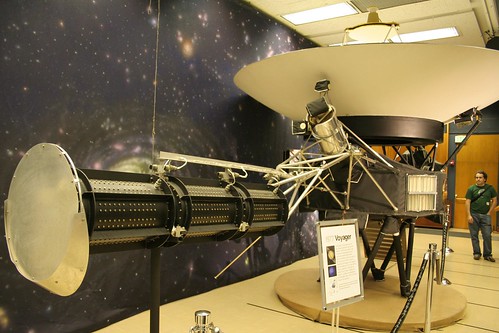
Yes, even on Friday the 13th, it’s time once again for the weekly round-up of science and astronomy stories.
- Voyager 1 becomes first human-made object to leave solar system
CNN
“Scientists now have strong evidence that NASA’s Voyager 1 probe has crossed this important border, making history as the first human-made object to leave the heliosphere, the magnetic boundary separating the solar system’s sun, planets and solar wind from the rest of the galaxy.” - New high-resolution atlas of asteroid Vesta is available to the public
Astronomy Magazine
“An atlas of the asteroid 4 Vesta, which scientists created from images taken during the Dawn Mission?s Low Altitude Mapping Orbit (LAMO), is now accessible for the public to explore online. The set of maps was made from mosaics of 10,000 images from Dawn?s framing camera instrument, taken at an average altitude of about 130 miles (210 kilometers).” - NASA sends unmanned rocket to the moon
CNN
“NASA launched an unmanned rocket to the moon Friday night to study its lunar atmosphere and environment. ? The Lunar Atmosphere and Dust Environment Explorer is designed to ‘orbit the moon to gather detailed information about the lunar atmosphere, conditions near the surface and environmental influences on lunar dust,’ NASA said.” - Coldest brown dwarfs blur lines between stars and planets
Astronomy Magazine
“A new study shows that while these brown dwarfs, sometimes called failed stars, are indeed the coldest known free-floating celestial bodies, they are warmer than previously thought, with temperatures about 250?350? Fahrenheit (121?177? Celsius).” - Death spiral: why the universe is producing fewer stars
Christian Science Monitor
“Two new studies attempt to explain how gases crucial to star formation are being expelled from galaxies, turning fertile spiral galaxies into fallow elliptical ones.” - NASA’s NuSTAR catching black holes on the fly
Astronomy Now
“NASA’s black-hole-hunter spacecraft, the Nuclear Spectroscopic Telescope Array, or NuSTAR, has “bagged” its first 10 supermassive black holes. The mission, which has a mast the length of a school bus, is the first telescope capable of focusing the highest-energy X-ray light into detailed pictures.” - IBEX measures changes in the direction of interstellar winds buffeting our solar system
Astronomy Magazine
“Data from NASA’s Interstellar Boundary Explorer (IBEX) spacecraft reveal that neutral interstellar atoms are flowing into the solar system from a different direction than previously observed.” - Scientists discover factors to predicting changes in comet rotation
Astronomy Magazine
“Planetary Science Institute (PSI) researchers have discovered a way to predict the changes in the rotational states of comets that could help scientists learn more about the approaching Comet ISON (C/2012 S1), which will pass by the Sun on Thanksgiving Day and has attracted worldwide interest because it may become sufficiently bright to be seen by the naked eye.” - Space and stars inspire play at Stahl Theatre
Northampton Chronicle & Echo
“Stella is a play by Siobhan Nicholas about time and space. Two astronomers, Jessica Bell from the 21st century and Caroline Herschel from the 18th century, look up at the same night sky and find themselves colliding in their search for understanding. Caroline longs for a family and home of her own while Jess contemplates the prospect of losing both.” - Astronomers explain why disk galaxies eventually look alike
Nanowerk
“It happens to all kinds of flat, disk galaxies ? whether they?re big, little, isolated or crowded in a cluster. They all grow out of their irregular, clumped appearance and their older stars take on the same smooth look, predictably fading from a bright center to a dim edge.” - Comet found hiding in plain sight
Astronomy Magazine
“For 30 years, a large near-Earth asteroid wandered its lone, intrepid path, passing before the scrutinizing eyes of scientists armed with telescopes while keeping something to itself. Astronomers have now discovered that the object, known as Don Quixote, whose journey stretches to the orbit of Jupiter, actually appears to be a comet.” - Texas astronomers unravel 20-year mystery about dark matter
Astronomy Magazine
“Astronomers at The University of Texas at Austin believe they have discovered the answer to a 20-year debate over how the mysterious cosmic ?dark matter? is distributed in small galaxies. Graduate student John Jardel and his advisor Karl Gebhardt found that the distribution, on average, follows a simple law of decreasing density from the galaxy?s center, although the details vary from galaxy to galaxy.”
Creative Commons photo: Voyager probe by rjshade.
